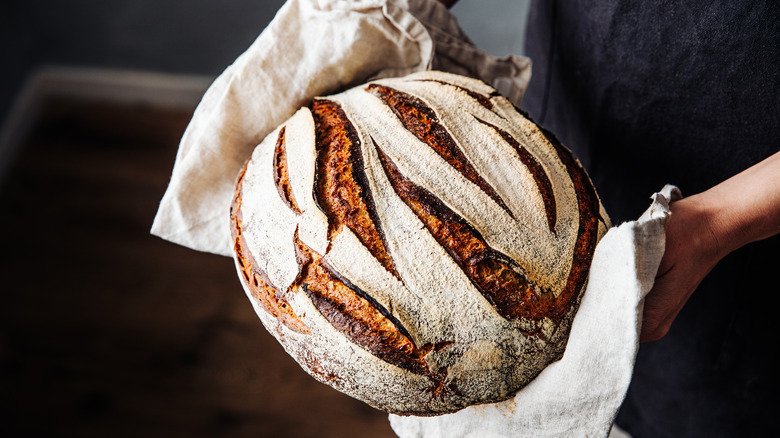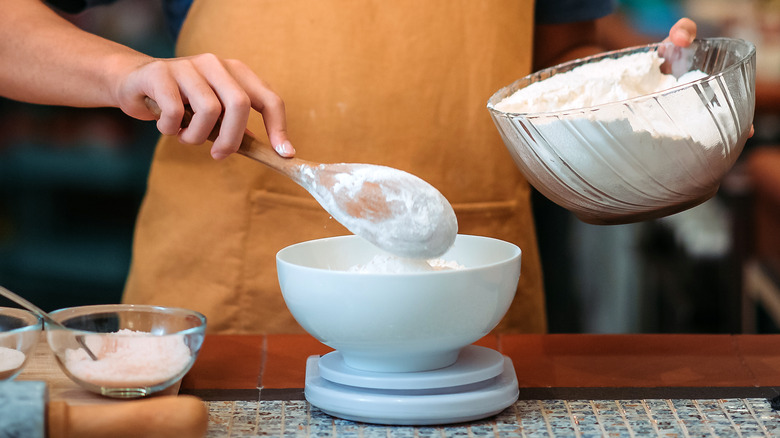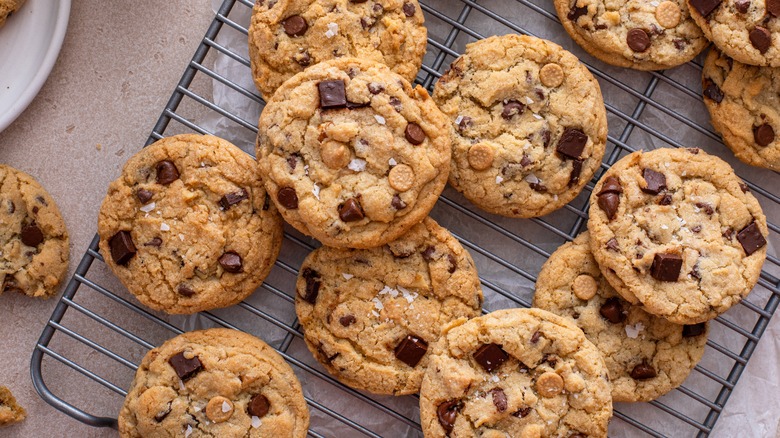The Flour Swap You Need For Towering Homemade Rye Bread
Whether you're embracing alternative flours, seeking out more sustainable grains, or craving tuna on rye, there are plenty of reasons to try your hand at a loaf of rye bread. The grain makes for a striking crumb and flavorful bite. Plus, it's rich in amylase, an enzyme that helps break down starch into the sugars that feed yeast — making it a beloved tool to encourage plenty of activity in sourdough starters.
As you begin baking, you may be tempted to add as much of the flour as possible and ditch your usual bag of all-purpose. But don't be so hasty to wave goodbye to wheat. It's the key to a higher rise.
Though rye delivers nuttiness and moisture to your bake, too much of it can produce a dense loaf. Don't blame your yeast; it's not an issue of leavening. The alternative grain, though not gluten-free, contains far less of the proteins that encourage gluten formation compared to wheat. That means it's not able to achieve the same height and squishy interior as your usual loaf. To strike the right balance of height and flavor, you'll need to keep using a portion of all-purpose flour and experiment with the ratio to build a towering loaf.
Balancing wheat flour and rye flour
Though it's tempting to jump into 100% rye, unless you're following a recipe designed to accommodate the flour, we suggest starting small. Replace a quarter of the recipe's wheat flour with rye. If you're already well-versed in making bread, you'll get a good sense of how this impacts the rise after a few test bakes and can start making adjustments based on your experience.
As you incorporate rye, you'll want to scale up the protein — without adding much more wheat. That's where bread flour and vital wheat gluten come in. Bread flour is designed to have a higher amount of protein than all-purpose or cake, which means bakers get more bang for their buck when they swap it in. Protein strengthens bread and helps it form gluten, which ultimately assists your dough in capturing air bubbles and staying puffy. And vital wheat gluten is exactly what it sounds like — a concentrated powdered gluten. Just remember, too much of a good thing can also hinder your bread, as overdeveloping the gluten can make your dough stodgy and tough.
You may wonder if opting for dark, medium, or white rye flour makes a difference. While white rye will give a slight boost, you'll mostly see a change in flavor rather than gluten. Dark rye is similar to whole wheat flour in that it's milled to contain more of the flavorful and hard outer shell, called the bran.
Other sweet uses for rye
The flour's lower gluten content is just one of the many things you didn't know about rye, the world's most underrated grain. Another fun fact is that it's perfect for sweet bakes, as well as your usual savory breads. Your bag of flour is begging to be put to use alongside deep and toasty flavors, as it can help infuse moisture and impart a fudgy quality.
Dark chocolate, molasses, browned butter, and toasted nuts are all delicious accompaniments to the natural aromas of the grain. It's also the perfect flour to pair with chocolate chip cookies for complex flavor. But don't stop there. Consider making a rich brownie or banana bread, both of which become dense and complex from the lower-gluten flour swap. Or bake a cake or gingerbread cookies with warming ginger, plenty of spices, and amber honey.
You can also let the grain shine on its own in a simple shortbread, but before you do, follow a few easy tips. Before using the flour, give it a toast on the stove or in the oven until it's fragrant, and you'll get even more of a tender bake and earthy flavors. And give the dough time to rest so it can rehydrate and develop texture. If you're using a recipe built for rye flour, you're ready to bake, but if you're making a swap for all-purpose, follow the same 25% rule to get started.



